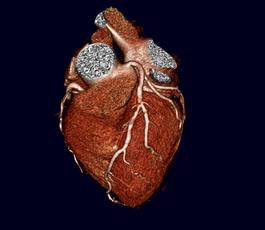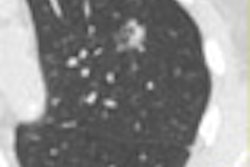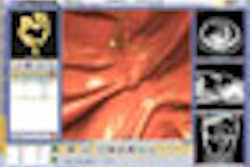
A study presented at today's American Heart Association (AHA) meeting in Orlando found 64-slice CT to be nearly as accurate as invasive catheter-based angiography for detecting coronary artery stenosis.
"Angiography will see smaller vessels than CT, but trouble comes in bigger vessels," said study co-investigator Dr. Joao Lima, from Baltimore's Johns Hopkins University, in a videotaped interview. "For the vessels that matter, CT is as good as angiography."
Researchers of the Coronary Artery Evaluation Using 64-Row Multidetector Computed Tomography Angiography (CORE 64) trial conducted at nine participating academic centers recruited 291 men and women 40 years and older (mean age, 59 years, 74% men, median BMI 27) with suspected coronary artery disease who were scheduled for invasive coronary angiography. In the study, 64-detector-row contrast-enhanced CT angiography (CTA) (Aquilion 64, Toshiba America Medical Systems, Tustin, CA) was added to the exam protocol before angiography, which served as the reference standard.
The participants were then followed up for a minimum of one year, in a process that will continue until 2009. Compared to angiography, the accuracy of 64-detector-row MDCT was 83% to 90% for detecting significant stenosis, "while tests using older 16-(slice) CT scans were in some instances only 20% to 30% as precise," the group wrote in a press release.
 |
| Color reconstruction of 64-slice CTA image of a patient's heart. Image courtesy of Johns Hopkins University. |
The improvement over typical 16-slice CT results was most pronounced in smaller vessels ranging from 2.5-4.0 mm in diameter, they explained; 64-slice CT yielded diagnostic image quality in 98% of all coronary vessels.
In a per-patient analysis compared to catheter angiography, MDCT's sensitivity for the detection of luminal stenosis greater than 50% was 85%, with specificity of 90%, positive predictive value of 91%, and negative predictive value of 83%, the authors reported. However, CT's sensitivity was lower in a per-vessel analysis: 76%, with specificity of 93%, positive predictive value of 82% and negative predictive value of 89%.
On a per-patient basis, the diagnostic ability of MDCT is good compared to catheter angiography, as reflected in an area under the curve (AUC) of 93% in patients with suspected coronary artery disease, and calcium scores of 600 or lower, the group concluded. Moreover, on a per-patient basis, MDCT was similar (84%) to catheter angiography (89%) in its ability to identify patients who underwent revascularization.
While invasive angiography remains the gold standard for detecting coronary artery stenosis, 64-slice CTA will constitute an important alternative or backup test, Lima said. CTA can also replace some stress testing, said principal investigator Dr. Julie Miller, an assistant professor of medicine at Johns Hopkins.
The use of 64-slice CT "will dramatically improve our ability to detect and treat people with suspected coronary disease and chest pain much earlier in their disease," Lima said.
By Eric Barnes
AuntMinnie.com staff writer
November 5, 2007
Related Reading
MDCT promising for long-term prognosis in patients with chest pain, November 5, 2007
CTA predicts functional recovery of the myocardium, September 7, 2007
Coronary CTA aids some asymptomatic patients, August 27, 2007
Simple scoring system predicts cardiovascular complications after PCI, June 22, 2007
Copyright © 2007 AuntMinnie.com




















